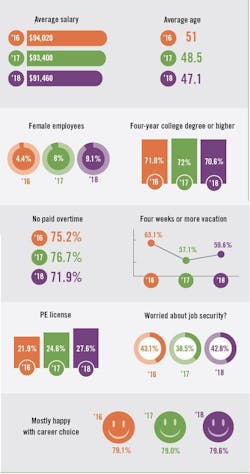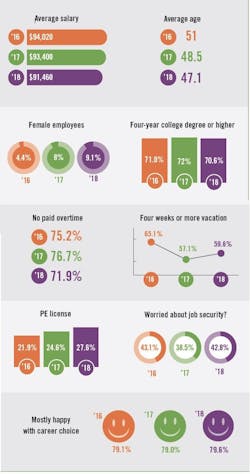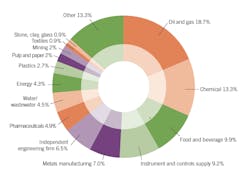It had to swing back eventually. After years of rapidly aging workforces, accelerating retirements, the brain drain of expertise, and questions about where it would get the next generation of engineers, technicians and operators, it appears the process control field's professionals are finally getting a little younger as a group.
For the last two years, the average age of respondents to Control's salary survey declined from 51 years in 2016 to 48.5 years in 2017 to 47.1 years in 2018. Admittedly, this isn't a very long span, and future results could contradict this assertion. However, given the ongoing pressures of veterans continuing to retire and rookies gradually drawn in to replace them, it's likely that the field's age profile will keep on ratcheting downward. Naturally, because older, more experienced process control pros are nearing the end of their careers, while their younger, less savvy counterparts are at the beginning, a decrease in the former and an increase in the latter impacts the survey's results in many categories, including total average salary, vacation, benefits and others.
Equally notable over the past two years, the number of women respondents in the process industries increased from 4.4% in 2016 to 8% in 2017, and reached 9.1% this year—seemingly poised to finally crack the 10% barrier. Though these increases accompany the respondents' younger profile and greater overall use of software and Internet tools in the process fields, it's unclear if any have a causal influence on each other.
Undercurrents and transitions
Beyond the numbers, securing veteran know-how before they depart and disseminating it among the newbies as they arrive is the biggest challenge facing the process-related industries. It's even more crucial than implementing digitalization, virtualization, cloud computing and the Industrial Internet of Things (IIoT) because these technical shifts rest squarely on how well end users, manufacturers, system integrators, suppliers and other organizations get their old and young staffers to bridge their generation gap, collaborate and achieve these essential transitions.
"We're an OEM that ties together components to complete pneumatic conveyors, but the Internet is causing all kinds of transitions," says respondent Norm Seidel, controls engineer at Magnum Systems in Kansas City, Kan. "We used to go tradeshows like Bulk and Powder and Pack Expo to secure leads, but lately we're getting more through the Internet, which means we're shifting to our website, and redirecting our communication efforts to LinkedIn, Facebook and other forms of social media.
"Once we have a lead, we talk directly with potential users about the controls they need, and begin to visualize how they'll be applied in their application and plant. This is a more traditional process, but once we approach startup on a job, we're using even more Ethernet, wireless routers, VNC servers, and Internet tools to test I/O and HMI displays. As a result, we need more people with these skills, but there aren't enough, so we're also using LinkedIn and Facebook to find them, too."
Brass tacks results
In all, 418 respondents completed Control's 2018 Salary Survey, while another 161 provided partial responses. Beyond being a bit younger on average, the respondents also reported average decreases in salary and a reduction in those earning four weeks of vacation, even though more are receiving bonuses and fewer are working unpaid overtime (Figure 1).
Figure 1: Along with a slightly younger average age, respondents to Control's 2018 salary survey also reported downticks in average salary and in the percentage receiving four weeks of vacation, while fewer are working unpaid overtime. Meanwhile, the number of women respondents reached 9.1% this year, and seems poised to finally crack the 10% barrier.
In addition, while respondents with four-year degrees and above has remained at about 70% or better for the past two years, the class of 2018 also had 10.3% with two-year degrees, and 7.4% attending technical school. The college graduates reported that 38% studied electrical engineering, 15% studied chemical engineering, 10% studied industrial engineering, 3% studied computer science, and 33% studied other subjects, including mechanical engineering, instrumentation and control, biology and chemistry.
Meanwhile, the percentage of pay raises up to $4,000 appears to have shrunk over the past two years from 87% in 2016 to 81.6% this year. However, this decline was accompanied by bonus levels that increased from 57% to 64% during the same period, perhaps due to some employers of tying compensation to performance-based incentives (Figure 2).
On the benefits side, possibly because senior personnel retain better packages because they've been with their employers longer, or maybe because those employers aren't as generous in recent years, benefits reported by 2018's respondent in the top six traditional categories were also a bit diminished during the past two years. The lone bright spot was a modest uptick in the number of respondents participating in pension plans (Figure 3).
As always, the industries and types of organizations in which process engineers, technicians and operators work are as varied as the backgrounds and education of the professionals performing them. Those fields with double-digit percentage representation—or close to it—include oil and gas (18.7%), chemical and other (13.3%), food and beverage (9.9%), instrument and controls supply (9.2%), and metals manufacturing (7.0%) (Figure 4).
Figure 2: While the percentages of pay raises up to $4,000 appears to have shrunk over the past two years, they were accompanied by bonus level that increased. This can perhaps be explained by the popular option among some employers of typing compensation to performance-based incentives.
Figure 3: Perhaps because senior personnel retained better packages from their employers—or maybe because those employers just aren't as generous lately—benefits in the top six categories slid a bit over the past two years. The lone bright spot was a modest uptick in the number of respondents participating in pension plans.
Figure 4: As always, the industries and businesses where process engineers, technicians and operators work are as different as the education and backgrounds of the professionals serving them.
School, skills, south Texas
One of the starkest examples of the need for more process control professionals is in the oil and gas plants and related petrochemical operations along the coastal bend of Texas. Just eight years ago, in the summer of 2010, combined production from the Permian Basin and Eagle Ford passed 1 million barrels per day (MMbpd). Since then, combined production has grown to more than 4 MMbpd, and the ban on crude exports has been lifted, providing tremendous opportunities for this coastal regional. They're receiving increasing attention and potentially huge investments as they take in more oil from the Permian and Eagle Ford areas because their counterparts four hours away in Houston are near capacity, according to respondent George Lister, instructor in the Process Technologies and Instrumentation program at Del Mar College in Corpus Christi. It teaches courses in process operations, industrial instrumentation with controllers tied to networks, welding, distributed control and others, which follow International Society of Automation'sAccreditation Board for Engineering and Technology (ABET) curriculum standard. The program also has a $1.3-million glycol distillation skid with an Emerson DeltaV DCS.
"Employment opportunities in the Texas Coastal Bend are numerous because Houston is full, and Exxon, Occidental Petroleum and the other players here are investing because they need skilled people, and are seeking to grow their workforces organically," says Lister. "We're expecting $38 billion to be invested on the north shore of Corpus Christi Bay during the next three to five years. The projects include Exxon's $11-billion ethylene cracker, two of five LNG process trains that Cheniere Energy is ready to fire up, and Voestalpine's hot briquetted iron (HBI) plant that will run iron ore through a natural gas fueled direct reduction process to produce purer iron."
To educate the personnel needed by these and other facilities, Lister reports that Del Mar doesn't just teach 125 students per semester on campus, but also takes its college-credit instrumentation courses to three local high schools. "Three years ago, we got $250,000 in seed money from the local industries to teach dual-credit courses in process technology, and we're still running a section of 12 students from three high schools every semester," explained Lister. "High school students that start these classes in their junior year will only need to complete three more classes after they graduate.
"These aren't their fathers' process applications and plants, but we embrace the new technologies. They're much more digital now, but we're still dealing with classic pressure, temperature, level and flow. We still take these naturally occurring phenomena, convert them to electrical signals, input them to controllers for computing, and send decisions back to actuators. What's changed is the networking and communications that joined the instruments and controls under the heading of automation."
Figure 5: To attract, develop, recruit, hire and retain new talent, process industry organizations use multiple methods, including getting out in their local communities and participating and/or sponsoring science, technology, engineering and math (STEM) programs, such as FIRST Robotics.
Warm bodies, well trained
Though not as desperate as the oil and gas companies in coastal bend, just over half of 2018's respondents report their organizations are facing a shortage of engineers, technicians and operators. To get essential skills onsite as fast as possible, 70.2% of respondents add their firms outsource professional and/or engineering services, while 26% add they're doing it more often; 13% are doing it less, and 61% are doing about the same.
Meanwhile, 77.6 % are happy with their own skills and knowledge, 17.9% are only "sort of" happy, and 4.5% are not happy. Fortunately, 81.9 % report their companies support skills training, though 18.1% do not. Among organizations that support training, the main sources are self-study (35.3%), employer (23.8%), on-the-job from colleagues (15.3%) and from an outside training firm (15.1%). Those that don't support training report its due to lack of time (35%), lack of management (27%), lack of money (24%) and other (14%).
To attract, develop, recruit, hire and retain new talent, the 2018 respondents add their companies use multiple methods. The most popular include print or online advertising (46.5%), LinkedIn, Facebook or other social media (44.9%), internships and co-op programs (41.1%) and visits to local universities, colleges, community colleges and high schools (37.3%). However, increasing percentages of respondents are also sponsoring local science, technology, engineering and math (STEM) programs such as FIRST Robotics teams (14.9%); holding open-house events and tours for local students, teachers, parents and the community (13.2%); participating in or coaching local STEM teams and programs (12.7%); helping develop process control and automation curricula at local colleges and high schools (8.4%), and even helping teach process control and automation at local colleges and high schools (8.1%) (Figure 5).
Similarly, another piece of good news on the human resources front is the percentage of process control firms offering no apprentice programs dropped from 64.7% in 2016 to 60.2 % this year. Likewise, one-year-or-less apprentice programs increased from 14.3% in 2016 to 18.8% in 2018, or almost the same percentage as the non-existent apprenticeships declined (Figure 6).
Figure 6: Despite some minor fluctuations in several categories, apprentice programs are on the upswing with one-year-or-less programs increasing, and companies with no programs decreasing by almost the same percentage.
About the Author
Paul Studebaker
Paul Studebaker

Leaders relevant to this article:







